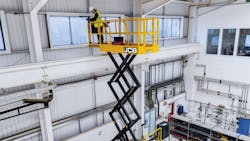Interview with Ben Coleman: Robust Construction and Ergonomic Design
Ben Coleman, general manager - product & commercial operations, JCB North America, talks about JCB’s new product range in the aerial market, growing worldwide demand for aerial products, and the value of enhanced telematics capability.
RER: What have been your most recent technological developments on your equipment?
Coleman: In March 2017, JCB has signaled its intention to become a major player in the $8-billion global aerial work platform market with the launch JCB Access, a range of 27 scissor lifts and articulated and telescopic booms.
What new technological developments are on the horizon for you?
Coleman: By the end of 2017, the JCB will offer 27 totally new Access platforms, covering more than 80 percent of the aerial work platform rental market. JCB has been developing and engineering this line-up of powered access machines for the past two years.
The line-up will include:
• Nine electric scissor lifts from 15 feet (4.6 m) to 45 feet (13.8 m)
• Three diesel rough-terrain scissor lifts
• Four diesel articulating booms from 50 feet (14.9 m) to 80 feet (24.6 m)
• One electric articulating boom with a working height of 45 feet (13.7 m)
• 10 diesel telescopic booms from 65 feet (20.6 m) to 135 feet (41.1 m)
In general, what trends do you see coming up in aerial equipment?
Coleman: Global demand for aerial work platforms is growing rapidly, up from $3 billion to $8 billion over the past eight years, and the market offers immense growth opportunities for JCB. Globally we will continue to see the market comprise of primarily of rental industry customers being served by a limited number of OEMs. The market demands a new supplier with JCB’s ability to offer a whole new standard in build quality, to set new industry norms for machine availability and low cost of ownership. With JCB’s 70-plus years of experience in construction equipment engineering and manufacturing, we believe that we are well positioned to meet the demands of the burgeoning rental industry, and meet its needs for aerial work platforms that are built to a higher standard.
What new safety developments and safeguards have you made on your equipment?
Coleman: All JCB Access electric scissor platforms feature four to six harness points. With fold-down rails and roller operated extension decks, many of the electric scissor models can fit easily through a standard doorway. Maneuverability is enhanced by the unique platform controller, which can be used from any side of the machine, at ground level or at elevation.
From an engineering standpoint, JCB Access machines are built to a higher standard. Full pivot bosses create an increased surface bearing area on the pivot pins. External limit switches are protected by full metal covers, and heavy-duty steel plate protection is featured throughout. Even the step treads and platform access gate benefit from JCB’s decades of experience in construction equipment manufacturing, with both featuring robust construction and ergonomic design for maximum safety.
JCB’s LiveLink telematic system will be incorporated as standard on all JCB Access booms, and it will be available as an option on the access scissors, providing customers and rental fleets in particular, with a full telematics link for increased security and maximum uptime.
Any new developments in training?
Coleman: JCB’s global dealer network has been undergoing full sales and service training to be able to provide world-class back-up for the access platform ranges.
In general, what are your expectations for the aerial market in the foreseeable future, in North America and internationally?
Coleman: Globally, JCB assesses the demand for aerial work platforms to be near 143,000 units a year, valued at approximately $8 billion annually, significantly up from $3 billion in 2009. This market demands a new supplier with JCB’s ability to offer a whole new standard in build quality, and industry-leading product support. JCB’s global network of 770 dealers, with 2,200 locations, can deliver the back-up that global customers expect.
About the Author
Michael Roth
Editor
Michael Roth has covered the equipment rental industry full time for RER since 1989 and has served as the magazine’s editor in chief since 1994. He has nearly 30 years experience as a professional journalist. Roth has visited hundreds of rental centers and industry manufacturers, written hundreds of feature stories for RER and thousands of news stories for the magazine and its electronic newsletter RER Reports. Roth has interviewed leading executives for most of the industry’s largest rental companies and manufacturers as well as hundreds of smaller independent companies. He has visited with and reported on rental companies and manufacturers in Europe, Central America and Asia as well as Mexico, Canada and the United States. Roth was co-founder of RER Reports, the industry’s first weekly newsletter, which began as a fax newsletter in 1996, and later became an online newsletter. Roth has spoken at conventions sponsored by the American Rental Association, Associated Equipment Distributors, California Rental Association and other industry events and has spoken before industry groups in several countries. He lives and works in Los Angeles when he’s not traveling to cover industry events.
